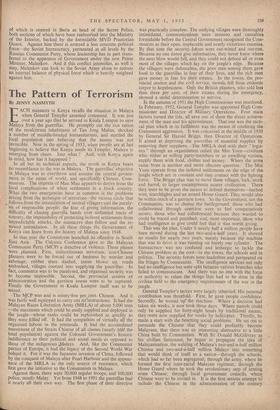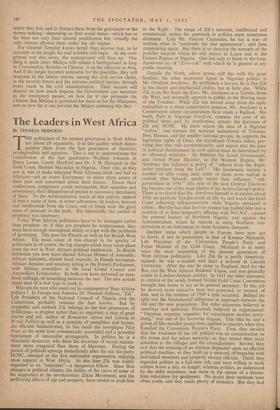The Pattern of Terrorism
By JENNY NASMYTH FACH massacre in Kenya recalls the situation in Malaya when General Templer assumed command. It was just 4 over a year ago that he arrived in Kuala Lumpur to save Malaya from the guerrillas. He promptly cut the rice ration of the recalcitrant inhabitants of Tan Jong Malim, shocked a number of muddle-headed humanitarians, and startled the local population into believing that the enemy was not invincible. Now in the spring of 1953, when people are at last beginning to believe that Kenya needs its Templer, Malaya is emerging from chaos. Into what ? And, with Kenya again in mind, how has it happened ?
In all but its technical aspects, the revolt in Kenya bears no resemblance to thp war in Malaya. The guerrillas' objective in Malaya was to overthrow and assume the central govern- ment in the name of world, and specifically Chinese, Com- munism. The impetus of Mau Mau appears to derive from the local complications of white settlement in a black country. What the two emergencies have in common is the problems arising from the technique of terrorism—the vicious circle that follows from the intimidation of neutral villagers'and the paraly- sis of responsible people; the fear of giving information, the difficulty of chasing guerrilla bands over unlimited tracts of country, the impossibility of protecting isolated settlements from unpredictable attacks, the massacres that follow and the re- newed intimidation. In all these things the Government of Kenya can learn from the history of Malaya since 1948.
In that year the Cominform launched its offensive in South East Asia. The Calcutta Conference gave to the, Malayan Communist Party (MCP) a directive of violence. Three phases were planned. First, indiscriminate terrorism; non-Chinese planters were to be forced out of business by murder and sabotage; rubber trees slashed, trains blown up, roads ambushed, villages coerced into supplying the guerrillas. In fact, commerce was to be paralysed, and organised security was to become impossible. Second, the provincial' centres of administration and the garrison towns were to be captured. Finally the Government in Kuala Lumpur itself was to be seized.- The MCP-Was and is ninety-five per cent. Chinese. And it was fairly well equipped to carry out its/instructions. It had the Malayan Races Liberation Army (MRLA) of about 5,000 men —the maximum which could be easily supplied and deployed in the jungle—whose ranks could be replenished as quickly as they were ,killed off. It had the sympathies of virtually all the organised labour in the peninsula. It had the accumulated resentment of the Straits Chinese of all classes (nearly half the total population) against the Colonial Government's historic indifference to their political and social needs as opposed to those of the indigenous Jvlalays. And, like the Communist .parties of Europe, it had the legacy of the Second World War behind it. For it was the Japanese invasion of China, followed by the conquest of Malaya after Pearl Harbour and the appear- ance of the MRLA as the only source of resistance, which first gave the initiative to the Communists in Malaya.
Against them, there were 30,000 regular troops, and 100,000 police, mostly Malay. Yet from 1948 to 1951 the guerrillas had it nearly all their own way. The first phase of their directive was practically complete. The outlying villages were thoroughly intimidated, communications were tenuous and casualties formidable before the Central Government recognised the Com- munists as their open, implacable and nearly victorious enemies. By that time the security filmes were out-witted and out-run. Because no one dared give information, they Never knew where the next blow would fall, and they could not defend all or even most of the villages which lay on the jungle's edge. Because the villagers were defenceless, the poor men among them gave food to the guerrillas in fear of their lives,' and the rich men gave money in fear for their estates. In the towns, the pro- vincial centres and the civil service, morale fell from endemic torpor to hopelessness. Only the British planters, who sold less than three per cent. of their estates during the emergency, showed a stolid determination to survive.
In the autumn of 1951 the High Commissioner was murdered. , In February, 1952, General Templer was appointed High Com- missioner and Director of Military Operations. Four main factors turned the tide, all save one of them the direct achieve- ment of the man and his appointment. That one was the tacti- cal plan which in its fulfilment was the means of confining the Communist aggression. It wag conceived in the middle of 1950 by General Sir Harold Briggs, then Director of Operations. It aimed at depriving the guerrillas of essential supplies by removing their suppliers. The MRLA deal with their " logis- tics " through an organisation called the Min Yuen—civilians who, either as willing party-members or as unwilling victims, supply them with food, clothes and money. Where the arms came from is another and more obscure question. The Min Yuen operate from the isolated settlements on the edge of the jungle which are in constant and easy contact with the fighting force. The Briggs plan was to move these villages, lock, stock and barrel, to larger encampments nearer civilisation. There they were to be given the means to defend themselves—barbed wire, searchlights and an armed Home Guard. They would also be within reach of a garrison town. So the Government, not the Communists, was to choose the battleground; those who had collaborated through coercion were to feel comparatively secure; those who had collaborated because they wanted to could be traced and punished; and, most important, those who had intelligence to give could feel that it Was. worth giving.
This was the plan. Under it nearly half a million people have - been moved during the last two-and-a-half years. It showed no results for nearly two years, mainly because the machine that was to drive it was running on barely one cylinder. The bureaucracy was too confused and lethargic to tackle the Chinese problem at the root—in the 'towns, the schools and in politics. The security forces were leaderless and permeated on the fringes by Communists. The intelligence services not only had no intelligence but were split between various branches who failed to communicate. And there was no one with the force or authority to relate the things that had to be done in the civilian field to the emergency requirements of the war in the jungle.
General Templer's tactics were largely inherited. His personal contribution was threefold. First, he gave people confidence. Secondly, he wound up the machine: Where a decision had taken six weeks, it now took three days. Where patrols could only be supplied for forty-eight hours by traditional means, they mere now supplied for weeks by helicopter. Thirdly, he made- a start with the besetting social problems. He set out to persuade the Chinese that they could profitably become Malayans, that there was an interesting alternative to a little China built by Communism. With Sir Donald McGilivray as his civilian lieutenant, he began to propagate the idea of Malayanisation, the welding of Malaya's two-and-a-half million Chinese and two-and-a-half million Malays into something that would think of itself as a nation—through the schools, which had so far been segregated; through the arniy, where hb formed the first inter-racial Malayan regiment; through the Home Guard where he took the revolutionary step of arming some Chinese; through local government councils, where Chinese were to be invited in. It is the first serious attempt to include the Chinese in the administration of the country where they live, and to distract them from the grievances or the money-making--depending on their social status—which has so far been not only their natural predilection but virtually the only interest allowed them under th old regime.
For General Templer knows bettei than anyone that, as he succeeds in the jungle, his real troubles will begin. As the over- ground war dies away, the underground will flare up. One thing is quite clear; Malaya will remain a battleground as long as Communism, Russian or Chinese, is on the offensive in Asia. And if the jungle becomes untenable for the guerrillas, they will reappear in the labour unions, among the civil service clerks, in the security forces and the extreme political parties, through every crack in the civil administration. Their success will depend on how much impetus the Government can maintain as the emergency passes; on how far it can persuade the Chinese that Malaya is governed for them as for the Malayans; and on how far it can prevent the Malays resenting this fact.



































 Previous page
Previous page